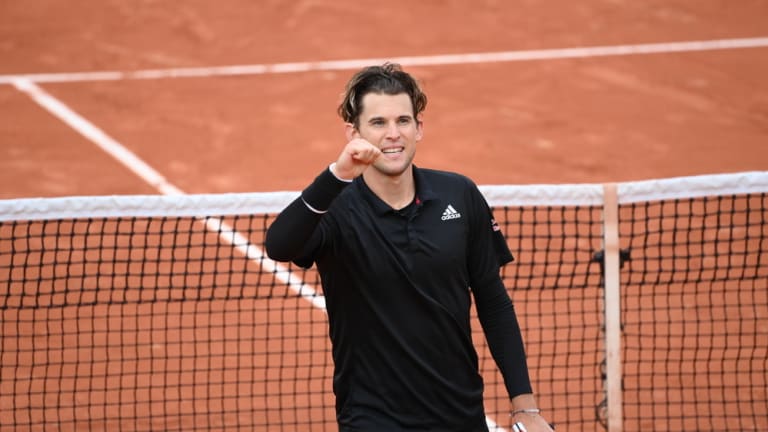Philippe Montigny / FFT
We will. In contrast, thousands of miles east from Sock’s America, Thiem drew a wide line of attack. The initially captivating shot is his scorching one-handed topspin backhand, a stroke that earns Thiem's applause from tennis aficionados in all corners of the globe. Thiem can also chip it low at a net-rusher’s feet, carve a drop shot, toss in a slice mid-rally. The forehand, if not always as singularly powerful as one of Sock’s best, can spread the court from rectangle to circle. Thiem is also increasingly comfortable at the net and able to hit a flat, slice or kick serve. The latter was particularly potent today when aimed wide to the vulnerable Sock backhand in the ad court.
Underpinning all of this is Thiem’s high fitness level and relentless focus. It’s hard to imagine him ever shirking a training routine. Balance, fitness, movement, power all aid his quest to strangle the opponent. “He can play his style for as long as he needs to,” said Sock. “Then usually, I would say his opponent is probably usually the one getting tired first out there. If the opponent is getting tired at all, his game will devastate you even more. Yeah, the discipline, the physical part of it is tough to match up on, especially on this surface.”
The difference between these two was instantly apparent. Thiem obliterated Sock in the first set. Making only two unforced errors to Sock’s 16, Thiem took just 28 minutes to win it, 6-1. The second set was marginally closer, Sock’s tenacity, problem-solving skills and flashes of athleticism helping him stay even through the first six games. Serving at 3-4, Sock fought off two break points but at last surrendered his delivery. Seeking to take a two sets to love lead at 5-3, Thiem went down love-30, but soon leveled the game. On his third set point, Thiem charged the net and clipped a deft crosscourt forehand volley winner. “Once he's in control, you know, control of the points, or playing ahead in the score, you know, he's tough to catch,” said Sock. “His ball is tough to catch up to out there, similar to a Rafa.”
The third set was far more competitive. Twice, Thiem went up a break, first serving at 2-1, then again at 4-3. Each time, Sock dug in and wisely experimented with various tactics. Having come to net eleven times in the first two sets, Sock made his way forward 18 in the third. It left me wondering: What if Sock made net-rushing less of an alternative and had instead extensively honed those skills early in his tennis life? Would he then treat his volley game as something other than a Plan B? Or was the die cast when victories came so easily to him as a junior? These are the questions I’ll bring if ever invited to a player development seminar.
Sock turned 28 last Thursday, an age young enough in contemporary tennis to give him room for encouragement. Ranked a career-high number eight at the end of 2017, as recently as February of this year, Sock didn’t even have a ranking. By March, Sock advanced from No. 767 to No. 384 and arrived at Roland Garros ranked No. 310. Of late, Sock has devoted far more time to his fitness, sharpening his body both on and off the court. He competed well this summer at both World Team Tennis and the US Open, winning his first round match there in a fifth-set tiebreaker. Making his way past three opponents in the qualifying at Roland Garros, Sock on Monday earned an impressive straight set victory over Reilly Opelka, his first main draw win at Roland Garros since 2016. Reflecting on his Paris journey, Sock said, “But I think hopefully I got the respect of the players that I'm on my way back and, you know, I obviously can play at that level again. Yeah, I'm just excited to move forward and keep playing good tennis.”
Thiem, the needle on his gas tank uncertain in the wake of his US Open run, expressed relief that today’s match did not go longer. “That's very important in the early rounds, to save energy, to play as less sets as possible,” he said. Thiem also added, “Of course, at one point I’m going to get super tired.” Who knows when?

